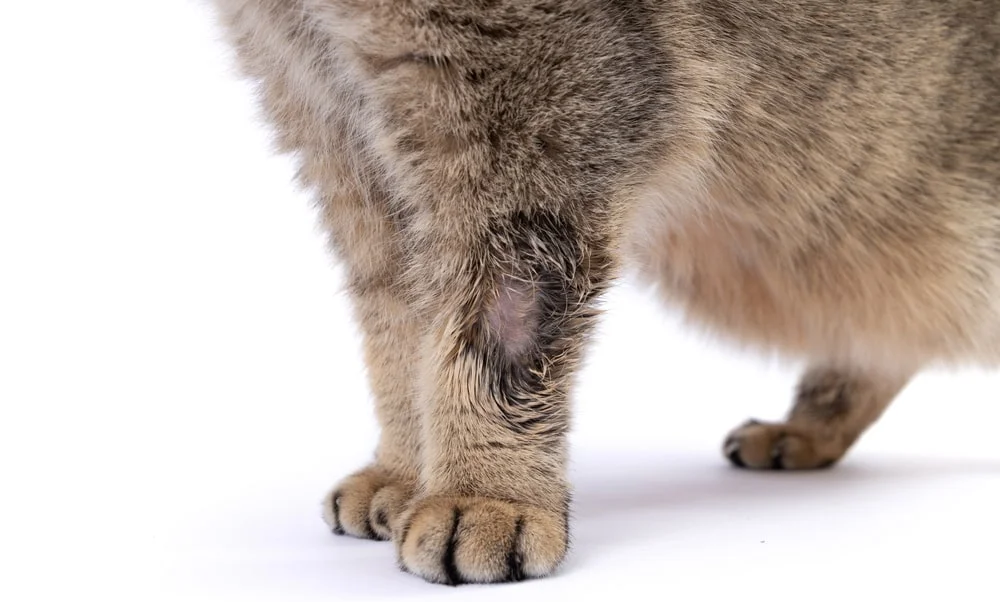PET HEALTH
You may have heard about ringworm before, but what exactly is it? Despite the name, ringworm has nothing to do with worms. Instead, it’s a fungal infection that can cause inflammation and create a distinctive red ring on the skin.
Ringworm in cats is as common as it is in dogs and humans. It’s also completely treatable. Let’s take a closer look at the signs of ringworm in cats and how to treat it.
How Do Cats Get Ringworm?
Ringworm is caused by a group of fungi called dermatophytes, hence the clinical name of the disease: dermatophytosis.1 Although ringworm is contagious, it requires direct contact with the fungus in order to spread.
Most cats get ringworm by brushing up against an infected animal or person. It’s also possible to catch ringworm from spores left on surfaces. Ringworm spores can survive in the environment for up to 18 months.1 It’s important to thoroughly clean combs, carpets, bedding, and other materials if you know you have a cat with ringworm in the house.
Is ringworm in cats contagious to humans?
Yes. Ringworm is highly contagious to any animal — including humans — who comes into contact with it. Children are especially susceptible, as are people with weaker immune systems. That’s why it’s so important to sanitize your home while treating your cat for ringworm.
Ringworm Can Be Scary. Vet Bills Don’t Have To Be.
Ringworm in Cats: Symptoms To Watch For
The most recognizable sign of ringworm in cats is the patch of red, irritated skin that marks the boundary of the fungal infection. However, it may not always look like a red ring. Finding the infected spot can also be difficult in cats, since it may be hidden beneath their fur. Instead, an ash-like dusting of skin in their coat may be the only indication of ringworm.
In addition to frequent itching, ringworm can also cause your cat to lose their fur around the infected site. This only happens if the fungus infects their hair follicles, but it does make it easier to identify ringworm. Hair loss most commonly occurs along a cat’s back, on their head, chest, or forelegs. Your cat may suffer from patchy fur in multiple locations if the ringworm has spread.
It’s also possible for ringworm to attack your cat’s claws. Infected claws become rough with a scaly base. If left unchecked, your cat’s claws can become deformed. If any of these symptoms appear, seek treatment for your kitty right away.
Diagnosing Ringworm in Cats
Recognizing the signs of ringworm is just the first step. The next is to bring your kitty to the vet for an official diagnosis. There are two primary ways your vet may go about this:1
- Wood’s lamp: Sometimes, ringworm can glow yellow-green under ultraviolet light. Vets can use a device called Wood’s lamp to highlight the infection this way, although it’s not always reliable. The infection could be obscured by fur, and certain types of ringworm don’t fluoresce.
- Fungus culture: The most accurate way to diagnose ringworm is by sampling their hair and skin to see if a dermatophyte culture will grow in a lab. This can take between 2 days and 3 weeks to confirm.
After obtaining a positive diagnosis, your vet will move on to treatment.
How To Treat Ringworm in Cats
Treating ringworm is relatively simple, but it can be an involved process lasting weeks or months.
The most important step is to eliminate all traces of ringworm from your cat’s environment. This may include a deep clean of your cat’s toys, bedding, and any areas in which they frequently spend time. A solution of one pint (500 ml) chlorine bleach and a gallon of water is usually enough to sterilize surfaces where dermatophyte spores could be present.1 It’s recommended to do this daily.
It’s also important to keep your infected cat away from any other animals in the house to prevent ringworm from spreading. Alternatively, you may want to treat all of your pets just in case. Your vet can recommend a plan they think will be most effective, including medication. During treatment, you’ll also need to bring your cat to the vet for regular skin and fur cultures to monitor their recovery progress.
Oral medication for ringworm
When treating ringworm, a vet will often prescribe an oral antifungal drug. Terbinafine and itraconazole are the most commonly used antifungals.1 Both are safe for pet use — although, they do have some common side effects.
Cats taking terbinafine may experience vomiting, decreased appetite, and diarrhea.2 A dose of terbinafine only lasts for 24 hours, so the side effects should dissipate quickly.
Itraconazole can also cause a decreased appetite, as well as swelling and skin lesions.3 More severe effects may include liver toxicity and inflammation of red blood cells, which can be recognizable by jaundice and severe diarrhea.
If you notice any of these effects, talk to your vet. They should be able to tell you whether it’s safe to continue administering the medication or not.
Topical medication for ringworm
In addition to an oral antifungal, your vet may recommend using a topical ointment that’s applied directly to the infected site. Topical treatment typically lasts for several weeks or months. The most commonly used topical medications contain miconazole or clotrimazole. Neither are known to have side effects, but an allergic reaction is possible.
Your vet may also suggest a specialized shampoo or lime sulfur dip. Bathe your cat twice weekly with the shampoo or lime sulfur. Be sure to wash your hands and all surfaces your cat came in contact with during the bath.
Pet Insurance Can Help You Manage Ringworm in Cats
Most cats recover from ringworm in a few weeks. The cost of treating ringworm in cats depends on the severity of the infection and the duration of treatment.4
For cats with a mild case of ringworm, you may only have to spend around $100 for topical treatment. However, a more challenging case requiring long-term treatment can cost as much as $500. That's not accounting for additional expenses, such as cleaning supplies to keep your home free of spores. The longer the infection lasts, the more expensive treatment becomes.
A surprise bill can be a burden for even the best-prepared pet parents. It’s an additional source of stress in an already stressful time, when you’d much rather be focusing on your cat’s health. Fortunately, it’s not a burden you need to face alone. A cat insurance policy could reimburse you for some of the cost of treatment and diagnosis.5
Let’s take a look at a real-life example of a MetLife Pet member. Jelly Belly was just a kitten when she came down with a ringworm infection in Austin, TX. Her treatment would have cost Jelly Belly’s parents nearly $200 — a heavy surprise to drop on new pet parents. But thanks to their cat insurance from MetLife Pet, they were reimbursed for almost $120, effectively cutting their bill in half.6
Don’t wait for your cat to catch ringworm. Getting a cat insurance policy early is one of the most effective steps you can take to keep them protected. Learn more about how our pet insurance works, or get a free quote now.
We can help handle the vet bill.
You handle the belly rubs.
855-270-7387



